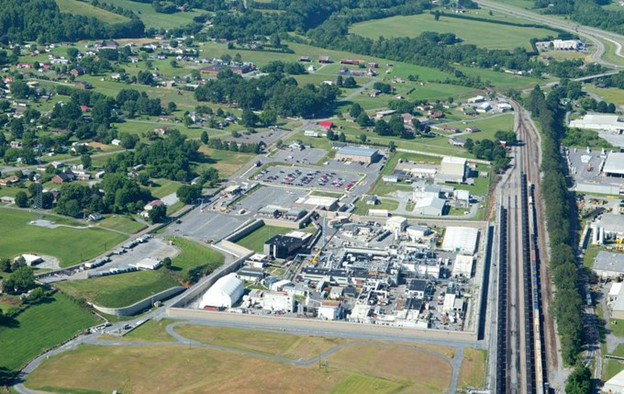The Nuclear Fuel Services facility in Erwin, Tenn. (Photo: BWXT)
BWX Technologies subsidiary Nuclear Fuel Services Inc. suspended operations last Friday at a Tennessee facility to assess conditions following Hurricane Helene. A company spokesperson said the site remained "in safe and secure condition."
NNSA administrator Jill Hruby (left) holds up the signed MOU on HEU conversion during the agency’s virtual meeting with Japan’s MEXT. (Credit: NNSA)
The Department of Energy’s National Nuclear Security Administration (NNSA) has signed a memorandum of understanding with Japan’s Ministry of Education, Culture, Sports, Science, and Technology (MEXT). The MOU describes their commitment to convert the Kindai University Teaching and Research Reactor (UTR-KINKI) from high-enriched uranium fuel to low-enriched uranium fuel. The nuclear nonproliferation–related agreement also calls for the secure transport of all the HEU to the United States for either downblending to LEU or disposition.
NNSA administrator Jill Hruby (right) and Ken Nakajima, director of the Institute for Integrated Radiation and Nuclear Science at Kyoto University, in the KUCA control room. (Photo: NNSA)
University of Tokyo technical experts practice procedures for HEU packaging at the Yayoi Research Reactor, with help from Savannah River personnel. (Photo: University of Tokyo)
President Joe Biden and Prime Minister Fumio Kishida of Japan have announced the successful removal of more than 30 kilograms of high-enriched uranium from three Japanese sites to the United States. The news came in a May 23 statement from the Department of Energy’s National Nuclear Security Administration.
ANS urges National Nuclear Security Administration to reconsider drafted rule
La Grange Park, IL – The American Nuclear Society (ANS) is recommending that the National Nuclear Security Administration (NNSA) consider using surplus plutonium from nuclear weapons as fuel for advanced reactors to generate carbon-free energy, rather than diluting and disposing 34 metric tons of weapons-grade plutonium at the Waste Isolation Pilot Plant (WIPP) in New Mexico as proposed by the NNSA.



 After more than a decade of global efforts led by the Department of Energy’s National Nuclear Security Administration, all four major medical producers of the radioisotope molybdenum-99 for the U.S. market are now using low-enriched uranium (LEU) in their production processes instead of high-enriched uranium (HEU), the latter of which presents risks of nuclear weapons proliferation.
After more than a decade of global efforts led by the Department of Energy’s National Nuclear Security Administration, all four major medical producers of the radioisotope molybdenum-99 for the U.S. market are now using low-enriched uranium (LEU) in their production processes instead of high-enriched uranium (HEU), the latter of which presents risks of nuclear weapons proliferation.





